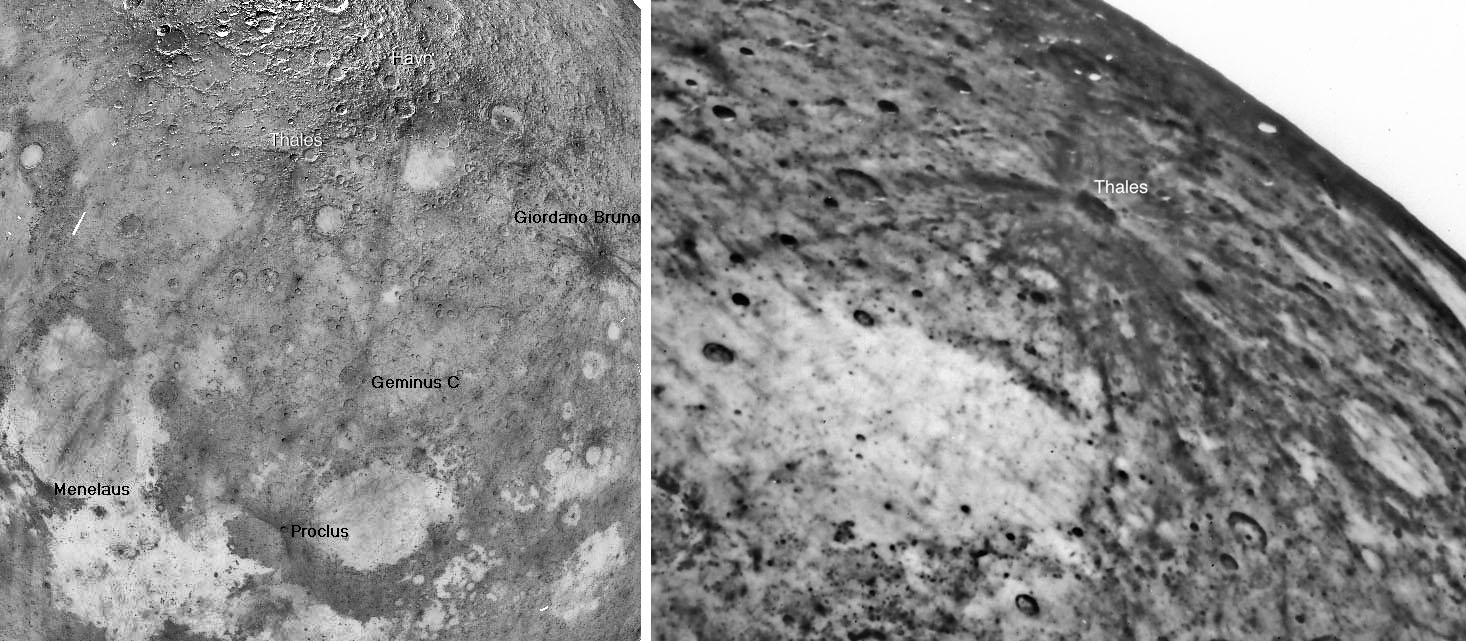
Clementine image (left) prepared by Jim Mosher, and Consolidated Lunar Atlas image (right)
Rays are pulverized rock and debris ejected as long ribbons of brightness from young impact craters. Today’s LPOD features two long rays that lack obvious primary craters. We have talked before about the origin of the Bessel ray, the conspicuous streak that passes through that crater and crosses Mare Serenitatis. Speculation is that it comes from Tycho (probably not) or Menelaus (no strong evidence). This rectified Clementine mosaic prepared by Jim with his LTVT software shows that the ray seems to bend slightly and continue hundreds of kilometers towards the northeast. The ray peters out near Thales, which is a young oblique impact ray crater. The ancient Consolidated Lunar Atlas (CLC) print (right) suggests that the northern portion of the Bessel ray (which passes near Mason & Plana) may be from Thales. The other Thalian rays aren’t as long this one, and no where near as long as the distance to Menelaus. So I think Thales is the source of the ray that reaches southward to Mason-Plana, but probably not for the Bessel segment. The second ray without an accepted origin is the bold one that slashes through Mare Humboldtianum. As the Clementine image shows, this goes directly south to Geminus C, north of Crisium. But Geminus C is a small crater to have such a long ray, and in fact, it doesn’t seem to be a ray crater at all. Nearby Messala B is also on the long ray and probably is a ray crater - but with short rays. At the north end the ray widens and aims directly at Hayn, just north of Mare Humboldtianum. There is a brightness around Hayn, especially to the east, but it is not clear to me that Hayn has any other rays. Unfortunately, the CLC full Moon print doesn’t have a good libration so it doesn’t help. This attempt to find parents for rays stresses the poor imagery that is available for such studies. The CLC prints are the best coherent set of full Moon images, but they are of low resolution (by today’s standards). There is a need for modern high resolution images with good librations and full Moon lighting to resolve this type of problem. Amateurs can make a difference here.
Technical Details:
Both of these images have been reversed so that bright regions are dark and vice versa. I just noticed what my be Lunar 101 - rays from the farside crater Giordano Bruno should be visible on the nearside east of Crisium!
Related Links:
Rükl plates 6, 7, 14 & 16
Yesterday's LPOD: 3.8 Billion Years of History
Tomorrow's LPOD: The Moon Never Sets on LPOD
COMMENTS?
Register, Log in, and join in the comments.



